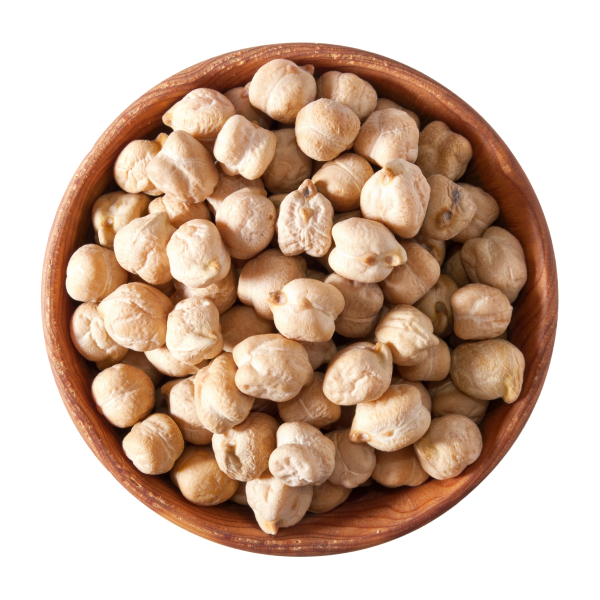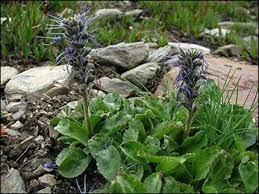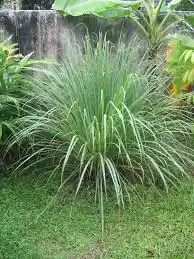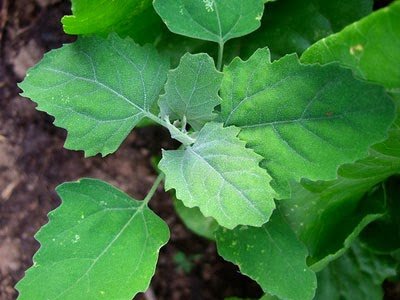Kabuli Chana Nutrition Requirements
Nutrition required by Kabuli Chana at each stage of its life cycle.
SOIL PREPARATION

Soil Preparation
Soil preparation is a critical step in Kabuli chana (Garbanzo beans) cultivation to ensure optimal plant growth and yield. Here's a general soil preparation method and nutrition requirement at the soil preparation stage for Kabuli chana:
Soil Preparation Method:
1. **Site Selection**: Choose a well-drained site with good sunlight exposure for Kabuli chana cultivation.
2. **Land Preparation**: Prepare the land by plowing or tilling to a depth of 15-20 cm to loosen the soil and break up clods.
3. **Soil Testing**: Conduct soil testing to assess nutrient levels, pH, and soil texture. Adjust soil pH if necessary to achieve the optimal range for Kabuli chana (pH 6.0-7.5).
4. **Incorporation of Organic Matter**: Incorporate well-decomposed organic matter such as farmyard manure or compost into the soil to improve soil structure, water retention, and nutrient availability.
5. **Fertilizer Application**: Based on soil test results and nutrient requirements, apply balanced fertilizers such as 20-25 kg/ha of nitrogen (N), 40-50 kg/ha of phosphorus (P), and 20-25 kg/ha of potassium (K). It's essential to ensure proper nutrient balance for optimal plant growth.
6. **Microbial Inoculants**: Optionally, apply microbial inoculants containing beneficial microbes like rhizobia to enhance nitrogen fixation in the soil, which can promote better growth and yield in Kabuli chana.
7. **Seedbed Preparation**: Create a fine and firm seedbed by leveling the soil surface to facilitate uniform seed placement and germination.
8. **Irrigation**: Pre-irrigate the field before sowing to ensure adequate soil moisture for germination and early growth of Kabuli chana.
Nutrition Requirement at Soil Preparation Stage:
- Kabuli chana has specific nutritional requirements during the soil preparation stage to support initial root development and establishment. Key nutrients needed include nitrogen (N), phosphorus (P), and potassium (K), along with secondary and micronutrients.
- Nitrogen (N) is essential for vegetative growth and overall plant development. Phosphorus (P) promotes root development and early flowering, while potassium (K) enhances disease resistance and stress tolerance.
- Ensure a balanced fertilizer application based on soil test results and recommended nutrient doses for Kabuli chana cultivation.
- Additionally, micronutrients like zinc, iron, and manganese are also important for Kabuli chana growth and should be included in soil amendments or fertilizer formulations if deficient.
Overall, proper soil preparation and balanced nutrient management are essential for establishing a healthy Kabuli chana crop with optimal growth and yield potential. Regular monitoring of soil fertility and nutrient levels throughout the growing season is crucial to address any deficiencies and ensure the crop's nutritional needs are met.
Early Growth (Germination to Establishment)

Early Growth
During the early growth stage (germination to establishment) of Kabuli chana (Garbanzo beans), the nutritional requirements of the crop are essential to support vigorous root and shoot development.
Here are the key nutrients required during this stage:
1. **Nitrogen (N)**: Nitrogen is crucial for promoting early vegetative growth, including root and shoot development. Adequate nitrogen availability ensures robust plant establishment and helps in the synthesis of proteins and enzymes necessary for various metabolic processes. Recommended nitrogen application rates during this stage typically range from 20 to 25 kg/ha.
2. **Phosphorus (P)**: Phosphorus plays a vital role in promoting root development and enhancing early plant vigor. Adequate phosphorus availability is crucial for optimal nutrient uptake, energy transfer, and early flowering. Recommended phosphorus application rates during this stage typically range from 40 to 50 kg/ha.
3. **Potassium (K)**: Potassium is essential for enhancing overall plant vigor and improving stress tolerance. It plays a critical role in water regulation, enzyme activation, and carbohydrate metabolism. Adequate potassium availability promotes healthy root growth and helps in the efficient utilization of other nutrients. Recommended potassium application rates during this stage typically range from 20 to 25 kg/ha.
4. **Micronutrients**: In addition to the primary macronutrients (N, P, K), Kabuli chana also requires essential micronutrients for optimal growth during the early growth stage. These micronutrients include zinc (Zn), iron (Fe), manganese (Mn), copper (Cu), boron (B), and molybdenum (Mo). While Kabuli chana usually obtains micronutrients from the soil, deficiency symptoms may occur if micronutrient availability is limited. It's essential to ensure adequate soil fertility and micronutrient levels through soil testing and appropriate fertilization or foliar applications if deficiencies are detected.
Overall, providing a balanced fertilizer application containing nitrogen, phosphorus, and potassium, along with sufficient micronutrients, is crucial during the early growth stage of Kabuli chana to ensure healthy establishment and vigorous growth of the crop. Regular monitoring of nutrient levels and plant health is essential to address any deficiencies and optimize nutrient management practices for optimal crop performance.
Tillering Stage (Shoot Development)

Tillering Stage
During the tillering stage (shoot development) of Kabuli chana (Garbanzo beans), the crop has specific nutritional requirements crucial for promoting vigorous vegetative growth and establishing a strong foundation for subsequent developmental stages.
Here are the key nutrients required during this stage:
1. **Nitrogen (N)**: Nitrogen is essential for promoting robust shoot development and leaf expansion during the tillering stage. Adequate nitrogen availability supports the synthesis of chlorophyll, proteins, and enzymes necessary for photosynthesis and overall plant growth. Nitrogen deficiency can lead to stunted growth and reduced yield potential. Recommended nitrogen application rates during this stage typically range from 20 to 30 kg/ha, depending on soil fertility and crop demand.
2. **Phosphorus (P)**: Phosphorus plays a critical role in promoting root development, energy transfer, and nutrient uptake during the tillering stage. Adequate phosphorus availability supports early shoot growth and enhances plant vigor. Phosphorus deficiency can restrict root growth and delay shoot development. Recommended phosphorus application rates during this stage typically range from 40 to 50 kg/ha, depending on soil test results and crop requirements.
3. **Potassium (K)**: Potassium is essential for promoting overall plant vigor and stress tolerance during the tillering stage. Adequate potassium availability supports root growth, water regulation, and enzyme activation, contributing to improved shoot development and plant health. Potassium deficiency can lead to reduced resistance to environmental stressors and compromised shoot development. Recommended potassium application rates during this stage typically range from 20 to 30 kg/ha, depending on soil potassium levels and crop demand.
4. **Micronutrients**: In addition to the primary macronutrients (N, P, K), Kabuli chana also requires essential micronutrients for optimal growth during the tillering stage. These micronutrients include zinc (Zn), iron (Fe), manganese (Mn), copper (Cu), boron (B), and molybdenum (Mo). While Kabuli chana usually obtains micronutrients from the soil, deficiency symptoms may occur if micronutrient availability is limited. It's essential to ensure adequate soil fertility and micronutrient levels through soil testing and appropriate fertilization or foliar applications if deficiencies are detected.
Overall, providing a balanced fertilizer application containing nitrogen, phosphorus, and potassium, along with sufficient micronutrients, is crucial during the tillering stage of Kabuli chana to ensure healthy shoot development and vigorous growth of the crop. Regular monitoring of nutrient levels and plant health is essential to address any deficiencies and optimize nutrient management practices for optimal crop performance.
Flowering

Flowering
During the flowering stage, kabuli channa (chickpeas) have specific nutritional requirements to support optimal growth and development. These requirements include macronutrients and micronutrients, which are essential for healthy plant growth and flower production.
Here's a general overview of the nutritional requirements during the flowering stage for kabuli channa:
1. **Nitrogen (N)**:
- Nitrogen is crucial during the flowering stage as it supports the formation of proteins and enzymes, which are essential for flower development.
- Kabuli channa typically requires moderate levels of nitrogen during this stage to promote healthy flower formation.
2. **Phosphorus (P)**:
- Phosphorus plays a vital role in flower initiation and development, as well as in promoting root growth.
- Kabuli channa requires adequate phosphorus during the flowering stage to support robust flower development and overall plant health.
3. **Potassium (K)**:
- Potassium is essential for flower and fruit development, as well as for improving plant resistance to stress.
- Kabuli channa needs sufficient potassium during the flowering stage to support the development of healthy flowers and ensure proper fruit set.
4. **Calcium (Ca)**:
- Calcium is important for cell wall formation and stability, which is essential for supporting flower structure and development.
- Kabuli channa requires calcium to be readily available during the flowering stage to prevent disorders such as blossom-end rot and ensure healthy flower development.
5. **Magnesium (Mg)**:
- Magnesium is a component of chlorophyll and plays a role in photosynthesis, which is essential for providing energy for flower development.
- Kabuli channa requires magnesium during the flowering stage to support photosynthesis and ensure healthy flower formation.
6. **Sulfur (S)**:
- Sulfur is essential for the formation of certain amino acids and proteins, which are important for flower development.
- Kabuli channa requires sulfur during the flowering stage to support protein synthesis and ensure healthy flower development.
7. **Micronutrients**:
- Micronutrients such as iron (Fe), manganese (Mn), zinc (Zn), copper (Cu), boron (B), and molybdenum (Mo) are required in smaller quantities but are still essential for various biochemical processes during flower development.
- Kabuli channa requires adequate levels of micronutrients to support enzyme activation and overall plant health during the flowering stage.
It's important to conduct soil tests to assess the nutrient levels and adjust fertilizer applications accordingly to meet the specific needs of kabuli channa during the flowering stage. Additionally, proper irrigation and management practices should be employed to ensure optimal nutrient uptake by the plants.
Matchuration & Ripening

Matchuration & Ripening
During the maturation and ripening stage of kabuli chana (chickpeas), the nutritional requirements shift to support the final stages of fruit development, seed maturation, and quality.
Here's an overview of the nutritional requirements during this stage:
1. **Potassium (K)**:
- Potassium plays a crucial role in the ripening process and contributes to fruit quality, flavor, and shelf life.
- Increased potassium uptake during this stage supports the proper ripening of kabuli chana seeds and enhances their quality.
2. **Phosphorus (P)**:
- Phosphorus continues to be important during the maturation and ripening stage for energy transfer processes and seed development.
- Adequate phosphorus levels support the maturation of kabuli chana seeds and ensure good seed quality.
3. **Calcium (Ca)**:
- Calcium helps maintain cell wall integrity and contributes to fruit firmness and quality during ripening.
- Kabuli chana requires sufficient calcium during this stage to support seed development and prevent disorders associated with calcium deficiency.
4. **Magnesium (Mg)**:
- Magnesium is involved in various enzyme activities and is essential for photosynthesis and energy transfer processes.
- Adequate magnesium levels during maturation and ripening support seed filling and overall plant health.
5. **Sulfur (S)**:
- Sulfur is important for protein synthesis and is a component of certain amino acids and vitamins.
- Kabuli chana requires sulfur during this stage to support seed protein synthesis and ensure good seed quality.
6. **Micronutrients**:
- Micronutrients such as iron (Fe), manganese (Mn), zinc (Zn), copper (Cu), boron (B), and molybdenum (Mo) continue to be important during maturation and ripening.
- These micronutrients support various biochemical processes associated with seed development, quality, and ripening.
7. **Nitrogen (N)**:
- While nitrogen requirements decrease during the maturation and ripening stage compared to earlier growth stages, a small amount of nitrogen is still needed to support seed filling and quality.
- Excessive nitrogen during this stage can lead to delayed maturity and reduced seed quality.
During the maturation and ripening stage, it's important to adjust fertilizer applications based on soil tests and plant nutrient uptake to meet the specific needs of kabuli chana. Proper irrigation and management practices should also be implemented to support optimal nutrient uptake and seed development during this critical stage.
Harvesting

Harvesting
During the harvesting stage of kabuli chana (chickpeas), it's important to focus on certain nutritional requirements and follow specific procedures to ensure a successful harvest with optimal yield and quality.
Here's a detailed overview:
1. **Nutritional Requirements**:
- At the harvesting stage, the primary focus shifts towards achieving optimal seed development and quality rather than promoting vegetative growth.
- While the nutritional requirements of the plant decrease during this stage, it's still essential to ensure adequate levels of nutrients in the soil to support seed filling and quality.
- Key nutrients needed during this stage include potassium (K) for seed maturation and quality, phosphorus (P) for energy transfer processes and seed development, and calcium (Ca) for maintaining cell wall integrity and seed quality.
2. **Procedure**:
a. **Timing of Harvest**:
- Harvesting should be done when the pods have reached physiological maturity. This is typically indicated by the pods turning yellow or brown and the seeds becoming firm and dry.
- Harvesting too early can result in immature seeds with lower yield and quality, while harvesting too late can lead to seed shattering and losses.
b. **Preparation for Harvest**:
- Before harvesting, inspect the field to assess the readiness of the crop. Remove any debris, weeds, or lodged plants that may interfere with the harvesting process.
- Ensure that harvesting equipment such as combine harvesters or specialized chickpea harvesters are properly calibrated and adjusted for optimal performance.
c. **Harvesting**:
- Kabuli chana can be harvested using combine harvesters equipped with appropriate headers for legume crops.
- Adjust the harvesting equipment settings to minimize seed damage and losses during the harvesting process.
- Harvest the crop during dry weather conditions to reduce the risk of seed spoilage and maintain seed quality.
d. **Post-Harvest Handling**:
- Promptly remove the harvested crop from the field to minimize exposure to weather conditions and pests.
- Store the harvested kabuli chana seeds in suitable storage facilities such as bins or silos to protect them from moisture, pests, and other damage.
- Clean and dry the harvested seeds thoroughly to reduce moisture content and prevent mold growth during storage.
e. **Storage**:
- Store the harvested kabuli chana seeds in cool, dry conditions to maintain seed quality and prevent deterioration.
- Regularly monitor the stored seeds for signs of moisture buildup, pests, or mold, and take appropriate measures to address any issues promptly.
By following these procedures and ensuring proper nutrition management during the harvesting stage, you can maximize the yield and quality of kabuli chana seeds and minimize post-harvest losses.
Kabuli Chana Farming Economics
Get details of Profitability and cost estimate in growing Kabuli Chana per acres of Land.
SOIL PREPARATION

Soil Preparation
Soil preparation is a crucial step in wheat cultivation, as it directly affects the crop's growth and yield. Here are the soil preparation methods and nutrition requirements at the soil preparation stage for wheat:
Soil Preparation Method:
Land Preparation: Plow the field to break the soil and turn it over. Use a disc harrow or cultivator to further break down clods and level the soil. Ensure proper seedbed preparation by creating a fine, well-tilled soil surface.
Seedbed Preparation: Level the field to provide a uniform surface for planting. Use a roller or a harrow to firm up the soil to facilitate seed-to-soil contact. Remove any weeds or crop residues from the previous season to reduce competition with the wheat crop.
Seed Rate and Sowing: Determine the appropriate seed rate based on the variety and local recommendations. Use a suitable seed drill for uniform and precise sowing. Ensure proper seed depth according to recommended guidelines.
Fertilization: Apply a balanced fertilizer based on soil nutrient analysis and regional recommendations. Incorporate fertilizers into the soil during seedbed preparation. Consider applying phosphorus and potassium along with nitrogen for optimal wheat growth.
Organic Matter: Incorporate well-rotted organic matter, such as compost or manure, into the soil. Organic matter enhances soil structure, water retention, and nutrient availability.
pH Adjustment: Check and adjust soil pH to the recommended range for wheat cultivation (typically around 6.0 to 7.5). Lime may be added to raise pH, and sulfur may be added to lower pH as needed.
Nutrition Requirement at Soil Preparation Stage: Nitrogen (N): Nitrogen is essential for vegetative growth and is crucial during the early stages of wheat development. Apply nitrogen fertilizer during soil preparation to provide an initial boost to the crop.
Phosphorus (P): Phosphorus is vital for root development and early plant establishment. Apply phosphorus-containing fertilizers, such as diammonium phosphate (DAP), during soil preparation.
Potassium (K): Potassium supports overall plant health, disease resistance, and drought tolerance. Apply potassium-containing fertilizers, such as potassium chloride (Muriate of Potash), during soil preparation.
Micronutrients: Consider incorporating micronutrients like zinc, copper, and boron based on soil testing results. Micronutrients play essential roles in enzyme activities and overall plant health.
Organic Matter: Organic matter contributes to nutrient availability and improves the soil's water-holding capacity. Ensure a good supply of organic matter through the incorporation of well-decomposed compost or manure.
Soil pH: Adjust soil pH to the recommended range for wheat cultivation to optimize nutrient uptake by the plants.
Microbial Activity: Encourage beneficial microbial activity in the soil by incorporating organic matter. Healthy soil microbial communities contribute to nutrient cycling and availability.
Water Management: Ensure proper drainage to prevent waterlogging, which can negatively impact nutrient uptake. Irrigate if necessary to maintain adequate soil moisture during wheat establishment.
Early Growth (Germination to Establishment)

Early Growth
Soil preparation is a crucial step in wheat cultivation, as it directly affects the crop's growth and yield. Here are the soil preparation methods and nutrition requirements at the soil preparation stage for wheat:
Soil Preparation Method:
Land Preparation: Plow the field to break the soil and turn it over. Use a disc harrow or cultivator to further break down clods and level the soil. Ensure proper seedbed preparation by creating a fine, well-tilled soil surface.
Seedbed Preparation: Level the field to provide a uniform surface for planting. Use a roller or a harrow to firm up the soil to facilitate seed-to-soil contact. Remove any weeds or crop residues from the previous season to reduce competition with the wheat crop.
Seed Rate and Sowing: Determine the appropriate seed rate based on the variety and local recommendations. Use a suitable seed drill for uniform and precise sowing. Ensure proper seed depth according to recommended guidelines.
Fertilization: Apply a balanced fertilizer based on soil nutrient analysis and regional recommendations. Incorporate fertilizers into the soil during seedbed preparation. Consider applying phosphorus and potassium along with nitrogen for optimal wheat growth.
Organic Matter: Incorporate well-rotted organic matter, such as compost or manure, into the soil. Organic matter enhances soil structure, water retention, and nutrient availability.
pH Adjustment: Check and adjust soil pH to the recommended range for wheat cultivation (typically around 6.0 to 7.5). Lime may be added to raise pH, and sulfur may be added to lower pH as needed.
Nutrition Requirement at Soil Preparation Stage: Nitrogen (N): Nitrogen is essential for vegetative growth and is crucial during the early stages of wheat development. Apply nitrogen fertilizer during soil preparation to provide an initial boost to the crop.
Phosphorus (P): Phosphorus is vital for root development and early plant establishment. Apply phosphorus-containing fertilizers, such as diammonium phosphate (DAP), during soil preparation.
Potassium (K): Potassium supports overall plant health, disease resistance, and drought tolerance. Apply potassium-containing fertilizers, such as potassium chloride (Muriate of Potash), during soil preparation.
Micronutrients: Consider incorporating micronutrients like zinc, copper, and boron based on soil testing results. Micronutrients play essential roles in enzyme activities and overall plant health.
Organic Matter: Organic matter contributes to nutrient availability and improves the soil's water-holding capacity. Ensure a good supply of organic matter through the incorporation of well-decomposed compost or manure.
Soil pH: Adjust soil pH to the recommended range for wheat cultivation to optimize nutrient uptake by the plants.
Microbial Activity: Encourage beneficial microbial activity in the soil by incorporating organic matter. Healthy soil microbial communities contribute to nutrient cycling and availability.
Water Management: Ensure proper drainage to prevent waterlogging, which can negatively impact nutrient uptake. Irrigate if necessary to maintain adequate soil moisture during wheat establishment.
Tillering Stage (Shoot Development)

Tillering Stage
Soil preparation is a crucial step in wheat cultivation, as it directly affects the crop's growth and yield. Here are the soil preparation methods and nutrition requirements at the soil preparation stage for wheat:
Soil Preparation Method:
Land Preparation: Plow the field to break the soil and turn it over. Use a disc harrow or cultivator to further break down clods and level the soil. Ensure proper seedbed preparation by creating a fine, well-tilled soil surface.
Seedbed Preparation: Level the field to provide a uniform surface for planting. Use a roller or a harrow to firm up the soil to facilitate seed-to-soil contact. Remove any weeds or crop residues from the previous season to reduce competition with the wheat crop.
Seed Rate and Sowing: Determine the appropriate seed rate based on the variety and local recommendations. Use a suitable seed drill for uniform and precise sowing. Ensure proper seed depth according to recommended guidelines.
Fertilization: Apply a balanced fertilizer based on soil nutrient analysis and regional recommendations. Incorporate fertilizers into the soil during seedbed preparation. Consider applying phosphorus and potassium along with nitrogen for optimal wheat growth.
Organic Matter: Incorporate well-rotted organic matter, such as compost or manure, into the soil. Organic matter enhances soil structure, water retention, and nutrient availability.
pH Adjustment: Check and adjust soil pH to the recommended range for wheat cultivation (typically around 6.0 to 7.5). Lime may be added to raise pH, and sulfur may be added to lower pH as needed.
Nutrition Requirement at Soil Preparation Stage: Nitrogen (N): Nitrogen is essential for vegetative growth and is crucial during the early stages of wheat development. Apply nitrogen fertilizer during soil preparation to provide an initial boost to the crop.
Phosphorus (P): Phosphorus is vital for root development and early plant establishment. Apply phosphorus-containing fertilizers, such as diammonium phosphate (DAP), during soil preparation.
Potassium (K): Potassium supports overall plant health, disease resistance, and drought tolerance. Apply potassium-containing fertilizers, such as potassium chloride (Muriate of Potash), during soil preparation.
Micronutrients: Consider incorporating micronutrients like zinc, copper, and boron based on soil testing results. Micronutrients play essential roles in enzyme activities and overall plant health.
Organic Matter: Organic matter contributes to nutrient availability and improves the soil's water-holding capacity. Ensure a good supply of organic matter through the incorporation of well-decomposed compost or manure.
Soil pH: Adjust soil pH to the recommended range for wheat cultivation to optimize nutrient uptake by the plants.
Microbial Activity: Encourage beneficial microbial activity in the soil by incorporating organic matter. Healthy soil microbial communities contribute to nutrient cycling and availability.
Water Management: Ensure proper drainage to prevent waterlogging, which can negatively impact nutrient uptake. Irrigate if necessary to maintain adequate soil moisture during wheat establishment.
Flowering

Flowering
Soil preparation is a crucial step in wheat cultivation, as it directly affects the crop's growth and yield. Here are the soil preparation methods and nutrition requirements at the soil preparation stage for wheat:
Soil Preparation Method:
Land Preparation: Plow the field to break the soil and turn it over. Use a disc harrow or cultivator to further break down clods and level the soil. Ensure proper seedbed preparation by creating a fine, well-tilled soil surface.
Seedbed Preparation: Level the field to provide a uniform surface for planting. Use a roller or a harrow to firm up the soil to facilitate seed-to-soil contact. Remove any weeds or crop residues from the previous season to reduce competition with the wheat crop.
Seed Rate and Sowing: Determine the appropriate seed rate based on the variety and local recommendations. Use a suitable seed drill for uniform and precise sowing. Ensure proper seed depth according to recommended guidelines.
Fertilization: Apply a balanced fertilizer based on soil nutrient analysis and regional recommendations. Incorporate fertilizers into the soil during seedbed preparation. Consider applying phosphorus and potassium along with nitrogen for optimal wheat growth.
Organic Matter: Incorporate well-rotted organic matter, such as compost or manure, into the soil. Organic matter enhances soil structure, water retention, and nutrient availability.
pH Adjustment: Check and adjust soil pH to the recommended range for wheat cultivation (typically around 6.0 to 7.5). Lime may be added to raise pH, and sulfur may be added to lower pH as needed.
Nutrition Requirement at Soil Preparation Stage: Nitrogen (N): Nitrogen is essential for vegetative growth and is crucial during the early stages of wheat development. Apply nitrogen fertilizer during soil preparation to provide an initial boost to the crop.
Phosphorus (P): Phosphorus is vital for root development and early plant establishment. Apply phosphorus-containing fertilizers, such as diammonium phosphate (DAP), during soil preparation.
Potassium (K): Potassium supports overall plant health, disease resistance, and drought tolerance. Apply potassium-containing fertilizers, such as potassium chloride (Muriate of Potash), during soil preparation.
Micronutrients: Consider incorporating micronutrients like zinc, copper, and boron based on soil testing results. Micronutrients play essential roles in enzyme activities and overall plant health.
Organic Matter: Organic matter contributes to nutrient availability and improves the soil's water-holding capacity. Ensure a good supply of organic matter through the incorporation of well-decomposed compost or manure.
Soil pH: Adjust soil pH to the recommended range for wheat cultivation to optimize nutrient uptake by the plants.
Microbial Activity: Encourage beneficial microbial activity in the soil by incorporating organic matter. Healthy soil microbial communities contribute to nutrient cycling and availability.
Water Management: Ensure proper drainage to prevent waterlogging, which can negatively impact nutrient uptake. Irrigate if necessary to maintain adequate soil moisture during wheat establishment.
Matchuration & Ripening

Matchuration & Ripening
Soil preparation is a crucial step in wheat cultivation, as it directly affects the crop's growth and yield. Here are the soil preparation methods and nutrition requirements at the soil preparation stage for wheat:
Soil Preparation Method:
Land Preparation: Plow the field to break the soil and turn it over. Use a disc harrow or cultivator to further break down clods and level the soil. Ensure proper seedbed preparation by creating a fine, well-tilled soil surface.
Seedbed Preparation: Level the field to provide a uniform surface for planting. Use a roller or a harrow to firm up the soil to facilitate seed-to-soil contact. Remove any weeds or crop residues from the previous season to reduce competition with the wheat crop.
Seed Rate and Sowing: Determine the appropriate seed rate based on the variety and local recommendations. Use a suitable seed drill for uniform and precise sowing. Ensure proper seed depth according to recommended guidelines.
Fertilization: Apply a balanced fertilizer based on soil nutrient analysis and regional recommendations. Incorporate fertilizers into the soil during seedbed preparation. Consider applying phosphorus and potassium along with nitrogen for optimal wheat growth.
Organic Matter: Incorporate well-rotted organic matter, such as compost or manure, into the soil. Organic matter enhances soil structure, water retention, and nutrient availability.
pH Adjustment: Check and adjust soil pH to the recommended range for wheat cultivation (typically around 6.0 to 7.5). Lime may be added to raise pH, and sulfur may be added to lower pH as needed.
Nutrition Requirement at Soil Preparation Stage: Nitrogen (N): Nitrogen is essential for vegetative growth and is crucial during the early stages of wheat development. Apply nitrogen fertilizer during soil preparation to provide an initial boost to the crop.
Phosphorus (P): Phosphorus is vital for root development and early plant establishment. Apply phosphorus-containing fertilizers, such as diammonium phosphate (DAP), during soil preparation.
Potassium (K): Potassium supports overall plant health, disease resistance, and drought tolerance. Apply potassium-containing fertilizers, such as potassium chloride (Muriate of Potash), during soil preparation.
Micronutrients: Consider incorporating micronutrients like zinc, copper, and boron based on soil testing results. Micronutrients play essential roles in enzyme activities and overall plant health.
Organic Matter: Organic matter contributes to nutrient availability and improves the soil's water-holding capacity. Ensure a good supply of organic matter through the incorporation of well-decomposed compost or manure.
Soil pH: Adjust soil pH to the recommended range for wheat cultivation to optimize nutrient uptake by the plants.
Microbial Activity: Encourage beneficial microbial activity in the soil by incorporating organic matter. Healthy soil microbial communities contribute to nutrient cycling and availability.
Water Management: Ensure proper drainage to prevent waterlogging, which can negatively impact nutrient uptake. Irrigate if necessary to maintain adequate soil moisture during wheat establishment.
Harvesting

Harvesting
Soil preparation is a crucial step in wheat cultivation, as it directly affects the crop's growth and yield. Here are the soil preparation methods and nutrition requirements at the soil preparation stage for wheat:
Soil Preparation Method:
Land Preparation: Plow the field to break the soil and turn it over. Use a disc harrow or cultivator to further break down clods and level the soil. Ensure proper seedbed preparation by creating a fine, well-tilled soil surface.
Seedbed Preparation: Level the field to provide a uniform surface for planting. Use a roller or a harrow to firm up the soil to facilitate seed-to-soil contact. Remove any weeds or crop residues from the previous season to reduce competition with the wheat crop.
Seed Rate and Sowing: Determine the appropriate seed rate based on the variety and local recommendations. Use a suitable seed drill for uniform and precise sowing. Ensure proper seed depth according to recommended guidelines.
Fertilization: Apply a balanced fertilizer based on soil nutrient analysis and regional recommendations. Incorporate fertilizers into the soil during seedbed preparation. Consider applying phosphorus and potassium along with nitrogen for optimal wheat growth.
Organic Matter: Incorporate well-rotted organic matter, such as compost or manure, into the soil. Organic matter enhances soil structure, water retention, and nutrient availability.
pH Adjustment: Check and adjust soil pH to the recommended range for wheat cultivation (typically around 6.0 to 7.5). Lime may be added to raise pH, and sulfur may be added to lower pH as needed.
Nutrition Requirement at Soil Preparation Stage: Nitrogen (N): Nitrogen is essential for vegetative growth and is crucial during the early stages of wheat development. Apply nitrogen fertilizer during soil preparation to provide an initial boost to the crop.
Phosphorus (P): Phosphorus is vital for root development and early plant establishment. Apply phosphorus-containing fertilizers, such as diammonium phosphate (DAP), during soil preparation.
Potassium (K): Potassium supports overall plant health, disease resistance, and drought tolerance. Apply potassium-containing fertilizers, such as potassium chloride (Muriate of Potash), during soil preparation.
Micronutrients: Consider incorporating micronutrients like zinc, copper, and boron based on soil testing results. Micronutrients play essential roles in enzyme activities and overall plant health.
Organic Matter: Organic matter contributes to nutrient availability and improves the soil's water-holding capacity. Ensure a good supply of organic matter through the incorporation of well-decomposed compost or manure.
Soil pH: Adjust soil pH to the recommended range for wheat cultivation to optimize nutrient uptake by the plants.
Microbial Activity: Encourage beneficial microbial activity in the soil by incorporating organic matter. Healthy soil microbial communities contribute to nutrient cycling and availability.
Water Management: Ensure proper drainage to prevent waterlogging, which can negatively impact nutrient uptake. Irrigate if necessary to maintain adequate soil moisture during wheat establishment.
Kabuli Chana Disease Details
Nutrition required by Kabuli Chana at each stage of its life cycle.
SOIL PREPARATION

Soil Preparation
During the soil preparation stage for chickpea cultivation, several diseases and pests can pose a threat to the crop. Here are some common ones and the precautions to prevent them:
1. **Diseases**:
a. **Fusarium Wilt**:
- Fusarium wilt is a fungal disease that affects the roots and stems of chickpea plants.
- Precautions:
- Use certified disease-free seeds.
- Practice crop rotation with non-host crops.
- Ensure proper drainage to prevent waterlogging, as Fusarium thrives in wet conditions.
- Apply fungicides before planting if necessary.
b. **Rhizoctonia Root Rot**:
- Rhizoctonia root rot is caused by the soil-borne fungus Rhizoctonia solani, which affects chickpea seedlings.
- Precautions:
- Ensure well-drained soil to prevent waterlogging.
- Practice crop rotation to reduce the buildup of pathogens in the soil.
- Use fungicide seed treatments if Rhizoctonia is a known problem in the area.
c. **Pythium Root Rot**:
- Pythium root rot is caused by various Pythium species and affects chickpea seedlings, especially in cool and wet conditions.
- Precautions:
- Ensure proper soil drainage and avoid overwatering.
- Plant chickpea seeds in well-drained soil when soil temperatures are warmer.
- Use fungicide seed treatments if Pythium is a known issue in the area.
2. **Pests**:
a. **Wireworms**:
- Wireworms are the larvae of click beetles and can damage chickpea seeds and seedlings by feeding on them.
- Precautions:
- Practice deep plowing before planting to expose wireworms to predators and environmental conditions that reduce their populations.
- Use insecticide seed treatments if wireworms are known to be present in the soil.
b. **Seedcorn Maggot**:
- Seedcorn maggot larvae can feed on germinating chickpea seeds, leading to poor germination and stand establishment.
- Precautions:
- Plant chickpeas when soil temperatures are warmer to avoid favorable conditions for seedcorn maggot activity.
- Use insecticide seed treatments if seedcorn maggot is a known problem in the area.
c. **Cutworms**:
- Cutworms are moth larvae that feed on chickpea seedlings, cutting them off at the base.
- Precautions:
- Use physical barriers like collars around seedlings to protect them from cutworm damage.
- Apply insecticide treatments if cutworm populations are high.
Implementing these precautions during the soil preparation stage can help prevent diseases and pests in chickpea crops and promote healthier plant growth from the beginning of the growing season.
Early Growth (Germination to Establishment)

Early Growing
During the early growth stage of chickpeas, several diseases and pests can affect germination and establishment. Here are common diseases and pests, along with precautions to prevent them:
1. **Diseases**:
a. **Damping Off**:
- Damping off is caused by various fungal pathogens (e.g., Pythium spp., Rhizoctonia spp., Fusarium spp.) that infect seeds and seedlings, leading to rotting and wilting.
- Precautions:
- Use high-quality, disease-free seeds.
- Plant chickpea seeds in well-drained soil to prevent waterlogging.
- Avoid overwatering and maintain proper soil moisture levels.
- Apply fungicide seed treatments before planting if damping off is a known problem in the area.
b. **Ascochyta Blight**:
- Ascochyta blight, caused by the fungus Ascochyta rabiei, can affect young chickpea plants, causing leaf spots, stem lesions, and damping off.
- Precautions:
- Use certified disease-free seeds.
- Practice crop rotation with non-host crops.
- Avoid overhead irrigation to minimize leaf wetness.
- Apply fungicides preventatively according to recommended schedules.
2. **Pests**:
a. **Cutworms**:
- Cutworms are moth larvae that feed on young chickpea seedlings, cutting them off at the base.
- Precautions:
- Use physical barriers like collars around seedlings to protect them from cutworm damage.
- Apply insecticide treatments if cutworm populations are high.
b. **Aphids**:
- Aphids are common pests that can feed on chickpea plants, causing damage and transmitting viral diseases.
- Precautions:
- Monitor plants regularly for aphid infestations.
- Use insecticidal soaps or natural predators like ladybugs to control aphid populations.
- Implement intercropping with plants that repel aphids, such as aromatic herbs like basil or cilantro.
c. **Thrips**:
- Thrips are small, slender insects that feed on chickpea leaves and can transmit viral diseases.
- Precautions:
- Monitor plants regularly for thrips infestations, especially on the undersides of leaves.
- Use insecticidal treatments if thrips populations are high.
Implementing these precautions during the early growth stage of chickpeas can help prevent diseases and pests, promote healthy seedling establishment, and ensure a successful crop. Regular monitoring of the crop and timely intervention if any signs of diseases or pests are observed are also crucial for effective management.
Tillering Stage (Shoot Development)

Tillering Stage
During the tillering stage (shoot development) of chickpeas, several diseases and pests can pose a threat to the crop. Here are common diseases and pests, along with precautions to prevent them:
1. **Diseases**:
a. **Ascochyta Blight**:
- Ascochyta blight, caused by the fungus Ascochyta rabiei, is a common disease affecting chickpeas during the tillering stage. It causes leaf spots, stem lesions, and can lead to significant yield losses.
- Precautions:
- Plant resistant chickpea varieties when available.
- Use certified disease-free seeds.
- Practice crop rotation with non-host crops.
- Avoid overhead irrigation to minimize leaf wetness.
- Apply fungicides preventatively according to recommended schedules.
b. **Botrytis Gray Mold**:
- Botrytis gray mold, caused by the fungus Botrytis cinerea, can affect chickpea plants during cool and humid conditions, leading to wilting, necrosis, and mold growth on leaves, stems, and pods.
- Precautions:
- Ensure good air circulation in the field by avoiding overcrowding and maintaining proper plant spacing.
- Practice crop rotation with non-host crops.
- Avoid overhead irrigation to minimize leaf wetness.
- Apply fungicides preventatively according to recommended schedules.
2. **Pests**:
a. **Aphids**:
- Aphids are common pests that can feed on chickpea plants during the tillering stage, causing damage and transmitting viral diseases.
- Precautions:
- Monitor plants regularly for aphid infestations.
- Use insecticidal soaps or natural predators like ladybugs to control aphid populations.
- Implement intercropping with plants that repel aphids, such as aromatic herbs like basil or cilantro.
b. **Thrips**:
- Thrips are small, slender insects that feed on chickpea leaves during the tillering stage, causing damage and transmitting viral diseases.
- Precautions:
- Monitor plants regularly for thrips infestations, especially on the undersides of leaves.
- Use insecticidal treatments if thrips populations are high.
Implementing these precautions during the tillering stage of chickpeas can help prevent diseases and pests, promote healthy shoot development, and ensure a successful crop. Regular monitoring of the crop and timely intervention if any signs of diseases or pests are observed are also crucial for effective management.
Flowering

Flowering
During the flowering stage of chickpeas, several diseases and pests can pose a threat to the crop. Here are common diseases and pests, along with precautions to prevent them:
1. **Diseases**:
a. **Ascochyta Blight**:
- Ascochyta blight, caused by the fungus Ascochyta rabiei, is a common disease affecting chickpeas during the flowering stage. It causes leaf spots, stem lesions, and can lead to significant yield losses.
- Precautions:
- Plant resistant chickpea varieties when available.
- Use certified disease-free seeds.
- Practice crop rotation with non-host crops.
- Avoid overhead irrigation to minimize leaf wetness.
- Apply fungicides preventatively according to recommended schedules.
b. **Botrytis Gray Mold**:
- Botrytis gray mold, caused by the fungus Botrytis cinerea, can affect chickpea plants during cool and humid conditions, leading to wilting, necrosis, and mold growth on flowers, pods, and stems.
- Precautions:
- Ensure good air circulation in the field by avoiding overcrowding and maintaining proper plant spacing.
- Practice crop rotation with non-host crops.
- Avoid overhead irrigation to minimize leaf wetness.
- Apply fungicides preventatively according to recommended schedules.
c. **Ascochyta Blight (Flowers)**:
- Ascochyta blight can also affect chickpea flowers, causing necrotic spots and blighting, which can lead to poor pod development and yield losses.
- Precautions:
- Implement timely and targeted fungicide applications during flowering, especially during periods of high humidity and rainfall.
- Use disease-resistant chickpea varieties if available.
2. **Pests**:
a. **Aphids**:
- Aphids can feed on chickpea flowers, causing damage and transmitting viral diseases.
- Precautions:
- Monitor plants regularly for aphid infestations, particularly on flowers.
- Use insecticidal soaps or natural predators like ladybugs to control aphid populations.
- Implement intercropping with plants that repel aphids, such as aromatic herbs like basil or cilantro.
b. **Thrips**:
- Thrips can feed on chickpea flowers, causing damage and transmitting viral diseases.
- Precautions:
- Monitor plants regularly for thrips infestations, particularly on flowers.
- Use insecticidal treatments if thrips populations are high.
Implementing these precautions during the flowering stage of chickpeas can help prevent diseases and pests, promote healthy flower development, and ensure a successful crop. Regular monitoring of the crop and timely intervention if any signs of diseases or pests are observed are also crucial for effective management.
Matchuration & Ripening

Matchuration & Ripening
During the maturation and ripening stage of chickpeas, several diseases and pests can pose a threat to the crop. Here are common diseases and pests, along with precautions to prevent them:
1. **Diseases**:
a. **Ascochyta Blight**:
- Ascochyta blight, caused by the fungus Ascochyta rabiei, can continue to affect chickpeas during the maturation and ripening stage. It causes leaf spots, stem lesions, and can lead to significant yield losses.
- Precautions:
- Monitor the crop regularly for signs of ascochyta blight and implement timely fungicide applications if necessary.
- Practice crop rotation with non-host crops.
- Avoid overhead irrigation to minimize leaf wetness.
- Use disease-resistant chickpea varieties if available.
b. **Botrytis Gray Mold**:
- Botrytis gray mold, caused by the fungus Botrytis cinerea, can affect chickpea plants during cool and humid conditions, leading to wilting, necrosis, and mold growth on flowers, pods, and stems.
- Precautions:
- Ensure good air circulation in the field by avoiding overcrowding and maintaining proper plant spacing.
- Practice crop rotation with non-host crops.
- Avoid overhead irrigation to minimize leaf wetness.
- Apply fungicides preventatively according to recommended schedules.
2. **Pests**:
a. **Pod Borers**:
- Pod borers are moth larvae that tunnel into chickpea pods during the maturation and ripening stage, causing damage to seeds.
- Precautions:
- Implement timely and targeted insecticide applications to control pod borer populations.
- Harvest chickpeas promptly when mature to minimize exposure to pod borer damage.
- Implement crop rotation to disrupt the life cycle of pod borers.
b. **Aphids**:
- Aphids can continue to feed on chickpea plants during the maturation and ripening stage, causing damage and transmitting viral diseases.
- Precautions:
- Monitor plants regularly for aphid infestations, particularly on pods.
- Use insecticidal soaps or natural predators like ladybugs to control aphid populations.
- Implement intercropping with plants that repel aphids, such as aromatic herbs like basil or cilantro.
Implementing these precautions during the maturation and ripening stage of chickpeas can help prevent diseases and pests, promote healthy seed development, and ensure a successful harvest. Regular monitoring of the crop and timely intervention if any signs of diseases or pests are observed are also crucial for effective management.
Harvesting

Harvesting
During the harvesting stage of chickpeas, while diseases are less likely to occur compared to earlier growth stages, there are still potential issues to consider. Here are some common concerns and precautions to prevent them:
1. **Pod Rot**:
- Pod rot can occur during the harvesting stage, especially if chickpeas are exposed to prolonged periods of moisture or humidity. This can lead to the development of fungal pathogens such as Botrytis cinerea or Alternaria spp., causing pod decay.
- Precautions:
- Harvest chickpeas promptly when they reach maturity to minimize exposure to moisture.
- Avoid harvesting chickpeas during wet weather conditions.
- Ensure proper airflow during drying and storage to prevent moisture buildup.
2. **Seedborne Diseases**:
- Seedborne diseases, such as Ascochyta blight or Fusarium wilt, can be spread during harvesting if infected seeds are collected and stored together with healthy seeds.
- Precautions:
- Use certified disease-free seeds.
- Clean harvesting equipment and storage facilities thoroughly before use.
- Avoid harvesting and storing visibly diseased seeds with healthy seeds.
- Implement proper sanitation practices to prevent cross-contamination.
3. **Pests**:
- While pests are less likely to cause significant damage during the harvesting stage, some pests may still be present, such as pod borers or stored grain pests like bruchid beetles.
- Precautions:
- Inspect harvested chickpeas for signs of pest infestation.
- Store harvested chickpeas in sealed containers to prevent access by pests.
- Use appropriate insecticides or fumigants if necessary to control pest populations in storage.
4. **Physical Damage**:
- Physical damage to chickpeas during harvesting and handling can increase the risk of post-harvest diseases and reduce seed quality.
- Precautions:
- Use appropriate harvesting equipment and techniques to minimize seed damage.
- Handle harvested chickpeas gently to prevent bruising or cracking.
- Store harvested chickpeas in suitable containers or bins to avoid physical damage during transportation and storage.
By following these precautions during the harvesting stage, you can minimize the risk of diseases and pests affecting chickpea quality and ensure a successful harvest with high-quality seeds. Regular monitoring and proper post-harvest management practices are also essential for maintaining seed quality during storage and subsequent use.









